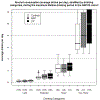Alcohol consumption, cigarette smoking, and the risk of recurrent acute and chronic pancreatitis
- PMID: 19506173
- PMCID: PMC6785300
- DOI: 10.1001/archinternmed.2009.125
Alcohol consumption, cigarette smoking, and the risk of recurrent acute and chronic pancreatitis
Erratum in
- Arch Intern Med. 2011 Apr 11;171(7):710
Abstract
Background: Recurrent acute pancreatitis (RAP) and chronic pancreatitis (CP) are associated with alcohol consumption and cigarette smoking. The etiology of RAP and CP is complex, and effects of alcohol and smoking may be limited to specific patient subsets. We examined the current prevalence of alcohol use and smoking and their association with RAP and CP in patients evaluated at US referral centers.
Methods: The North American Pancreatitis Study 2, a multicenter consortium of 20 US centers, prospectively enrolled 540 patients with CP, 460 patients with RAP, and 695 controls from 2000 to 2006. Using self-reported monthly alcohol consumption during the maximum lifetime drinking period, we classified subjects by drinking status: abstainer, light drinker (< or =0.5 drink per day), moderate drinker (women, >0.5 to 1 drink per day; men, >0.5 to 2 drinks per day), heavy drinker (women, >1 to <5 drinks per day; men, >2 to <5 drinks per day), or very heavy drinker (> or =5 drinks per day for both sexes). Smoking was classified as never, past, or current and was quantified (packs per day and pack-years).
Results: Overall, participants' mean (SD) age was 49.7 (15.4) years; 87.5% were white, and 56.5% were women. Approximately one-fourth of both controls and patients were lifetime abstainers. The prevalence of very heavy drinking among men and women was 38.4% and 11.0% for CP, 16.9% and 5.5% for RAP, and 10.0% and 3.6% for controls. Compared with abstaining and light drinking, very heavy drinking was significantly associated with CP (odds ratio, 3.10; 95% confidence interval, 1.87-5.14) after controlling for age, sex, smoking status, and body mass index. Cigarette smoking was an independent, dose-dependent risk factor for CP and RAP.
Conclusions: Very heavy alcohol consumption and smoking are independent risks for CP. A minority of patients with pancreatitis currently seen at US referral centers report very heavy drinking.
Conflict of interest statement
Potential conflict of interest relevant to this manuscript: None
Figures







References
-
- Etemad B, Whitcomb DC. Chronic pancreatitis: diagnosis, classification, and new genetic developments. Gastroenterology 2001;120:682–707. - PubMed
-
- Ammann RW, Akovbiantz A, Largiader F, Schueler G. Course and outcome of chronic pancreatitis. Longitudinal study of a mixed medical-surgical series of 245 patients. Gastroenterology 1984;86:820–828. - PubMed
-
- Andersen BN, Pedersen NT, Scheel J, Worning H. Incidence of alcoholic chronic pancreatitis in Copenhagen. Scand J Gastroenterol 1982;17:247–52. - PubMed
-
- Lankisch PG, Assmus C, Maisonneuve P, Lowenfels AB. Epidemiology of pancreatic diseases in Luneburg County. A study in a defined german population. Pancreatology 2002;2:469–477. - PubMed
-
- Layer P, Yamamoto H, Kalthoff L, Clain JE, Bakken LJ, DiMagno EP. The different courses of early- and late-onset idiopathic and alcoholic chronic pancreatitis. Gastroenterology 1994;107:1481–1487. - PubMed
Publication types
MeSH terms
Grants and funding
LinkOut - more resources
Full Text Sources
Other Literature Sources
Medical
Miscellaneous

